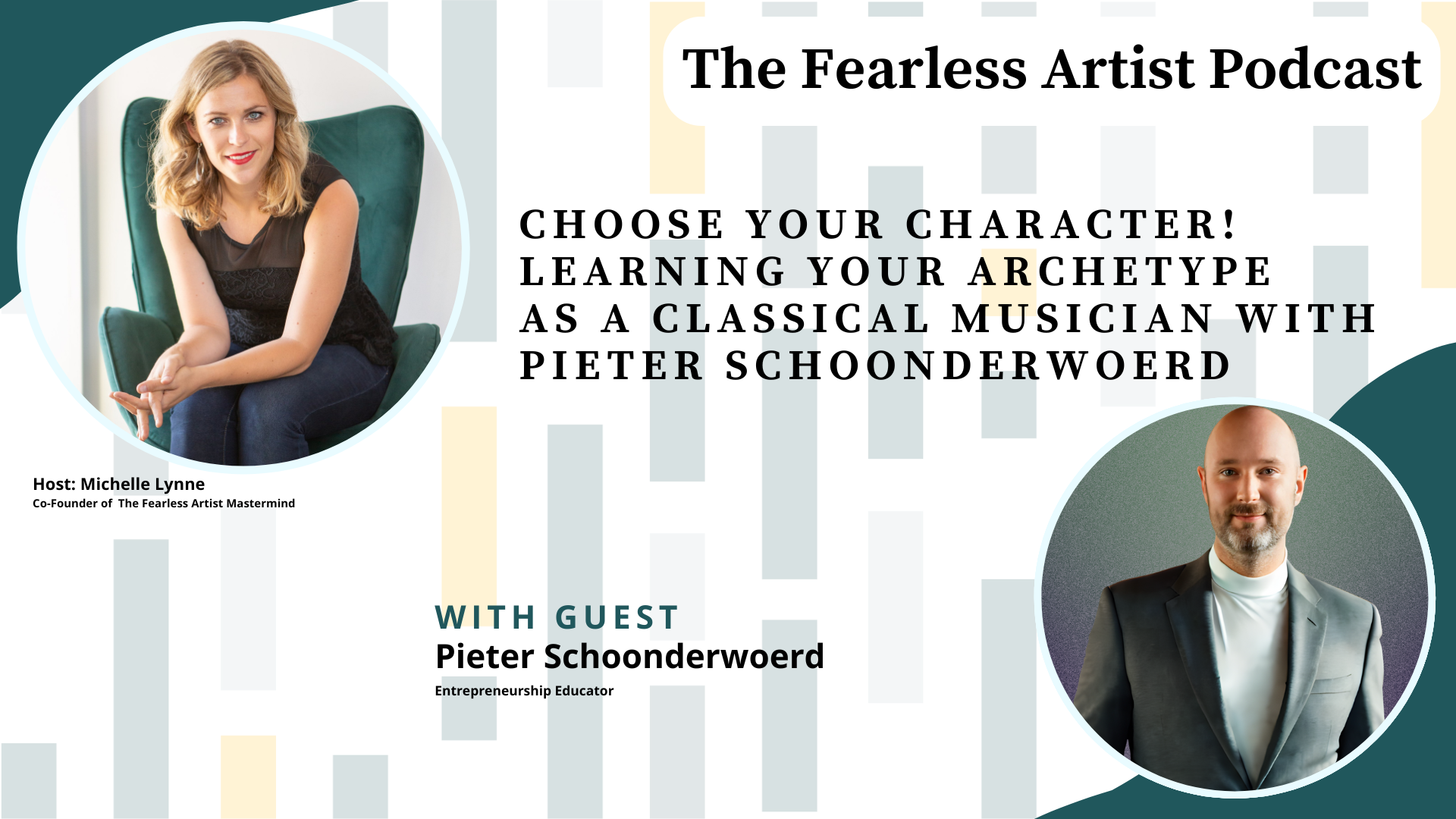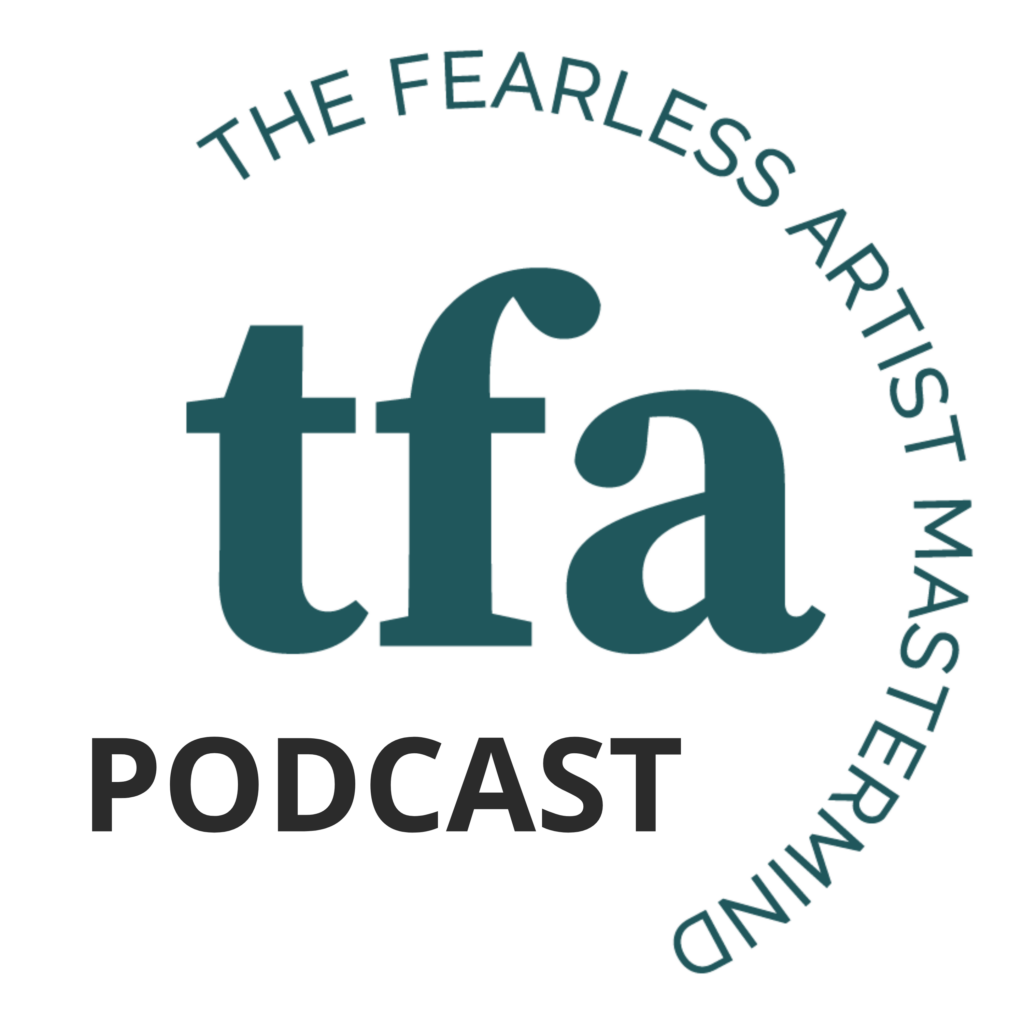Choose your character! Learning your archetype as a classical musician with Pieter Schoonderwoerd

Transcript:
Michelle Lynne: Welcome back to the Feel Artist podcast. I’m your host, Michelle Lynn, and today I am thrilled to have for the second time my colleague and friend Peter Award. Welcome, Peter.
Pieter Schoonderwoerd: Hi. Great to be here, Michelle.
Michelle Lynne: Yes. We had you on in one of our early episodes, and you gave one of the most helpful teachings on the podcast. I recommend that episode constantly around branding, and very specifically how to brand yourself as an artist through three things: actions, visuals. I’d love for you to first give us a quick intro, and then let’s just jump in—‘cause we’re gonna be going even deeper on this really important topic today.
Pieter Schoonderwoerd: Perfect. Well, for your listeners that don’t know me, my name is Peter Ward. I’ve been teaching music entrepreneurship for five years now in Rotterdam at a conservatory called CoArts. Before that, I founded the subject at the Conservatory of Maastricht in the south of the Netherlands, called “Your Artist in Business.” So I’ve been working with young musicians in an educative role for—let’s say—close to nine years. Besides that, I’ve worked in the music business as a venue programmer and as a director of a jazz venue in several capacities—all the way from artist manager to working in catering when I was 20 or 21, to now, 20 years later, in all these different roles. Along the way, besides being a musician myself and having studied jazz drums, you pick up things you now utilize in music teaching, but also as an artist coach.
Michelle Lynne: Yeah.
Pieter Schoonderwoerd: I work with artists on their artist branding.
Michelle Lynne: Yeah, it’s amazing. The best thing about you is that you’ve done bits and pieces of all of it. So when you come into a situation, you’re talking from your experience—you’ve put yourself in the shoes of who you’re talking to. It’s not just empty air or good ideas. A lot of times in academia, people come in with concepts, but we need practical teaching that works in the real world. Having worked with venues and programming, you know the nitty-gritty of what’s happening—dynamics of people and relationships, getting along in bands, making performances possible. Why is branding so important to you, and why is this kind of the topic of your season of life right now?
Pieter Schoonderwoerd: It’s the difference between just being a note and having personality, color, expression.
Michelle Lynne: Hmm.
Pieter Schoonderwoerd: A lot of people play amazingly, but they never think about: what’s my core personality? How can I communicate my way? What is my way of doing things—without comparing ourselves and finding some average way? Admitting that if I’m in control of this live show—I’m the master of the universe for an hour or two from the moment people arrive to when they leave—what impact do I want to have? The feelings, the atmosphere I want to create, and what can I do to make it truly my performance? That’s something I love working on: taking something impersonal and putting my stamp on it.
Michelle Lynne: Yeah. Coming from a classical music perspective, most of us are so self-focused on stage—we want to be perfect, play perfectly. It’s shifting now to think about what the audience wants and what we want to give them. But some audiences are elite classical listeners—they expect interpretation and critique—while others might be at their first concert and are blown away by anything. It’s hard for us, with so much to do, to think about these things. Why is this subject so interesting to you, and why have you chosen it?
Pieter Schoonderwoerd: Slowly, as an artist manager, I realized all your decisions—what to post on social media, what to wear, what repertoire—need a foundation. Otherwise it’s random, following trends or what everyone else does. If you want conscious decisions, it has to come from the inside. That’s branding.
Michelle Lynne: Yeah.
Pieter Schoonderwoerd: You ask, “Who am I?” and from the inside out you make decisions based on your beliefs, values, tastes, lifestyle, and the people you want at your concert. Thinking about those things is where branding comes in.
Michelle Lynne: Yeah, it’s amazing. I’m looking forward to diving in. I know you just wrote an ebook—you had three days off and cranked out a 50-page ebook, free for download. We’re gonna make sure that’s in the show notes.
Pieter Schoonderwoerd: Perfect.
Michelle Lynne: So, dive in and tell us what’s in there—starting with core values or archetypes, whatever you want.
Pieter Schoonderwoerd: I’ve been thinking about a great starting point: archetypes, which are core personalities. We start with who you are at your core as a personality type, then what drives you and what change you want to see in the world. These concepts, used for corporations and personal branding, are also for artists. Carl Jung wrote about core universal personality types—you recognize them anywhere. For example, the Jester cracks jokes; the Rebel does her own thing; the Ruler is about control, leadership, status; confidence and power. There are 12 archetypes. You figure out which resonates with you, choose one, and it brings focus and clarity.
Michelle Lynne: Hmm.
Pieter Schoonderwoerd: If you’re the Everyman—you’re the Ray Chen or Ed Sheeran of classical music—very approachable and relaxed; you could hang out in a pub even if you’re a superstar. That’s one archetype. Another is the Innocent: nature is important, inner child, maybe naive and dreamy. You’d wear white, have plants on stage, nature sounds.
Michelle Lynne: Mm-hmm.
Pieter Schoonderwoerd: You write lyrics or dedicate songs to nature. Working with an archetype limits your choices in a good way—it admits color and focus.
Michelle Lynne: Okay, this is my next question: what do you say to the classical musician who doesn’t want to box themselves in, or doesn’t want to be seen as the Jester because they want to be taken seriously in a very serious genre?
Pieter Schoonderwoerd: First, you’re boxing in to stand out in people’s minds—you need hooks. If you write an email to someone new, what sticks in their mind? What corner do you want to occupy? That’s to help others find and remember you. Second, if you are the Jester, decide how often you crack jokes—context is up to you. It’s culturally dependent. Your bio should make me smile—a bit of lightness and creativity. It’s about helping people connect to you, not just your professional achievements. If your bio lists competitions and masterclasses, I don’t see who you are. Infuse your communication with personality and humanness. A second way to color what you do is your art—your style and interpretation—another form of boxing in, but it gives you a unique sound.
Michelle Lynne: Right.
Pieter Schoonderwoerd: If you don’t choose, you end up random and blending in. Branding is about standing out. You can adjust as you go if feedback shows your brand doesn’t resonate. Yesterday I found old videos of my first website—it was off, but now we’ve strengthened core values and messaging.
Michelle Lynne: Yeah.
Pieter Schoonderwoerd: A final thought on archetypes: Seth Godin defines “remarkable” as “worth making a remark about,” which lives in the tension between being recognizable and being remarkable. Recognizable means people understand what you do; remarkable means you add personality—your archetype, art, and social position—to make people take note. All combined gives you many ingredients to play with. You exclude some things by choosing, but it’s creative, not limiting.
Michelle Lynne: I love that. So, after archetypes, you move to core values?
Pieter Schoonderwoerd: Yes. Once you know your archetype, values are about behavior—what motivates you. Choose up to five values, your “north star.” For example, empowerment might guide job offers or creative projects. Values also help decisions: if empowerment is key, choose opportunities that let you empower others. It removes emotion from decisions—if something doesn’t align with your values, you know to let it go.
Michelle Lynne: That’s so beautiful—and ties into “Start With Why.” If I know I help people, I can produce an ebook out of that “why.”
Pieter Schoonderwoerd: Exactly. Values give you a moral compass. When you face two options, you pick the one that aligns.
Michelle Lynne: Also helps with people-pleasing—knowing my values gives clarity even if I disappoint people.
Pieter Schoonderwoerd: And it can kick your butt: push yourself to fulfill those values—grow your community, impact more people.
Michelle Lynne: I love this. How do people discover their core values?
Pieter Schoonderwoerd: Three ways: 1) Look at your upbringing—family, community—and name a value that was important. 2) Think of an artist who inspires you—what do you admire in them? 3) Recall a key life decision you’re proud of—what value underlay it? Then refine the word—persistence, dedication, grit.
Michelle Lynne: From my Alberta farmer background, hardworking and loyalty come to mind—persistence, grit. And I admire Taylor Swift’s connection to fans—honesty, sincerity, community care.
Pieter Schoonderwoerd: Perfect. Once you have a value, ask: what does this mean for my performance, repertoire, ensemble, or interpretation? Make a creative challenge to embody it in each action. Three values are enough.
Michelle Lynne: This feels like healing—you see where you belong and it eases comparison and timeline pressure. Serve your audience with your gifts.
Pieter Schoonderwoerd: Flexing your creative muscle also strengthens your entrepreneurial muscle: instead of thinking “I missed out,” ask, “What can I create with my resources and network?”
Michelle Lynne: Right—the phone will start ringing because you stand out.
Pieter Schoonderwoerd: I once coached a Dutch rock artist who branded himself “Indie Rave”—two genres in one. He included that label in his booking email and people remembered him. He also had a rebel’s tagline: “As long as MDMA is illegal, my music is the only legal alternative.” Funny, rebellious, memorable—booking requests followed.
Michelle Lynne: Amazing. I’d love to see that in classical: “As long as LSD is illegal, come to my concert.”
Pieter Schoonderwoerd: That would be refreshing!
Michelle Lynne: I did have someone do cocaine at one of my candlelight concerts—they escorted him out. I thought, “Is that the vibe I give off?”
Pieter Schoonderwoerd: Incredible.
Michelle Lynne: This is so helpful. I need an artist branding session for my concert series—we spend so much time on existing repertoire; branding is about experiencing you playing Bach, not just hearing Bach.
Pieter Schoonderwoerd: Exactly—Bach has a brand; your goal is to have your own amazing brand.
Michelle Lynne: How can people find you and get your ebook?
Pieter Schoonderwoerd: I’m active on Instagram and LinkedIn as Pieter Schoonderwoerd. My website is alwayslookatthebrandsideoflife.com. I’ll upload the ebook there; DM me on Instagram or LinkedIn, and I’ll send it by email or in chat.
Michelle Lynne: If you need the Archetype ebook, DM us on Instagram @FearlessArtistMastermind. Peter, thank you so much for this wealth of information and digging in.
Pieter Schoonderwoerd: Michelle, thank you.
Michelle Lynne: Okay, everybody, thanks for listening. We’ll see you in the next episode—screenshot and share to your stories, and until next time, be fearless.
Guest:
Pieter Schoonderwoerd
Entrepreneurship Educator
From drumteacher, director of a jazz organization, programmer at a large music venue, artist career coach, non-profit board member, cultural economist, and music entrepreneurship lecturer at several Dutch conservatories. After 15+ years as a professional in the Dutch music sector in a variety of roles, I realized I have a gift for combining creative thinking with strategic clarity. It helped me increase visitor attendance by 300% at Jazz Maastricht, and successfully applied to 20+ Dutch funds for support, including FPK, Pr Bernhard Cultuurfonds, AFK, VSB Fonds, BNG Cultuurfonds, Stg. Zabawas and Stg. Dioraphte started several companies and helped probably 995+ emerging artists build sustainable music careers.
Some see me as a coach, others as a fundraiser, an endangered few as a musician, and the international jazz world knows me as chair of the VNJJ. I describe myself as a “Possibilist” – I think in and make artistic and business possibilities happen.

Subscribe to The Fearless Artist Podcast
Intro/Outro music by Michelle Lynne • Episode produced by phMediaStudio, LLC
